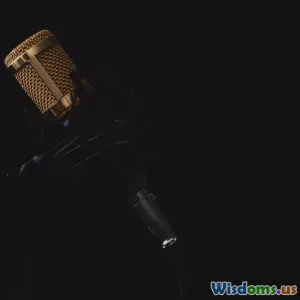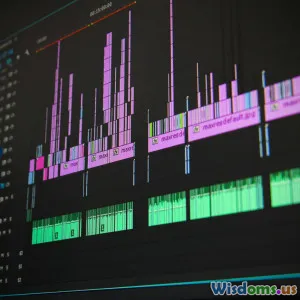
The Most Unusual Morphological Processes in Rare Languages
13 min read Explore rare languages' most fascinating and unexpected ways of word formation, with real examples and deep insights. (0 Reviews)
The Most Unusual Morphological Processes in Rare Languages
Languages, like living organisms, evolve in jaw-dropping ways—complex, odd, and delightfully creative. But what happens when the usual word-making mechanisms give way to wild, mind-bending strategies? What if, instead of adding a simple ending, a language stacked a dozen, or built words by jumping into the middle, or even by rhythmically echoing syllables into a symphony of meaning? Get ready to step beyond the boundaries of grammar textbooks and enter the lush, untamed jungle of rare language morphology.
Introduction: A World Beyond Prefixes and Suffixes
Linguists often describe language as if it were a set of standard building blocks: prefixes, suffixes, roots—snap them together and words emerge! But human creativity knows few bounds. While large languages like English, Spanish, or Mandarin are already full of quirks, some of the earth’s rarest and smallest tongues explode the very notion of how words get built. Their morphological processes**—the ways they change, combine, or embellish roots to generate meaning—**push the outer limits of what we might expect.
Why do these weird strategies exist? Often, their uniqueness grows from intense isolation, deep tradition, or specific communication needs—even climate or local mythology. Discover the world’s rarest strategies, illustrated with concrete examples and new linguistic discoveries that will challenge the way you think about words and meaning.
Morphology 101: A Brief Recap
Morphology studies how languages build words. The most familiar processes are:
- Affixation: Adding prefixes, suffixes, and sometimes infixes.
- Reduplication: Repeating all or part of a word for added meaning.
- Compounding: Stringing two (or more) words together.
- Suppletion: Replacing a stem entirely to express a grammatical change (e.g., go – went).
In rare languages, these can take on extreme or wholly unexpected forms. Let’s break down the truly outlandish.
Body: Extraordinary Morphological Phenomena
1. Infixes, Circumfixes, and Interdigitation: Morphology in the Middle
Affixes are usually thought of at the ends or beginnings of words. But in some rare cases, new meaning is inserted in the middle of a root or woven through it.
Infixation: Words with a Middle Twist
Infixation is notoriously rare in the world’s languages. Tagalog (Philippines) is a famous example, but even rarer is Chamicuro (a critically endangered language from Peru):
- punu (‘body’) → puminu (‘my body’)
The infix mi signals possession! Infixes can mark tense, ownership, number, or size, diving right into a word like a secret code.
English’s Playful Infixes
Although English doesn’t “normally” infix, occasional playful versions appear:
- abso-bloody-lutely (in Emotional British English)
But in many rare languages, this is business as usual, not an exception.
Circumfixes: Bookends with a Purpose
Circumfixes surround a word root on both sides, sandwiched into one piece of meaning.
In Tulilá language (a nearly vanished language of the Chaco region):
- hani (say) → kuhanipe (I will say: ku- and -pe)
Nonlinear Morphology and Interdigitation: Semitic Patterns and Beyond
Nonlinear, or templatic morphology is most widely found in Semitic languages (like Arabic, Hebrew). But some rare Berber and Chadic languages create new words by dropping root consonants into vowel “templates.”
- Berber: Consonant root {M-L-X} + various vowels → imlex, uxmal, etc.
What makes some rare languages unique isn’t having this template, but using it for things others would mark with an independent word: expressing subjects, aspects, or shadings of politeness.
"We don’t just add pieces at the edge; our entire root is reborn between vowels,” explains Dr. Ljubo Petrović, field linguist among the Tuaregs.
2. Lengthy Suffix Chains: One Word, Ten Morphemes
In some languages, a single word can pile up chains of suffixes—each adding a little layer of meaning. Two terrific examples come from the Uralic and Eskimo-Aleut families.
Chukchi: Siberia’s Suffix Champions
Chukchi (spoken in northeastern Siberia) is legendary for its verb suffix stacks. Here’s a striking example:
- nɨɣe-plɨn-əttəkɬɨn-eŋŋə-nəg-nee-tə
“You would not have made X for us”
This single word contains three different persons, a negative, a future, an object marker, a plural, and more. Each holds its own position in the word. Linguists sometimes joke that a polite conversation in Chukchi is like weaving a thick rope with each thread standing for a nuance the grammar demands.
Yupik and Inuit: Words as Sentences
Central Siberian Yupik and West Greenlandic Inuit embed vast amounts of information. In Inuit:
- qaqqasuuropuugami
“Because he acted as if he were extremely tired”
Here: qaq-qa-suu-ro-pu-uga-mi → ‘tired-extremely-appear-because' all bundled, often yielding entire sentences as single words.
Real-World Insight
How do these speakers keep track? It’s intensely studied how children in these cultures master such complexities quickly. Cognitive scientist Vera Reyes notes:
“By age five, children already reliably harness the system. It’s as natural as stacking building blocks—just with far more rules!”
3. Extreme Reduplication: From Plurality to Social Attitude
Most languages occasionally repeat a root for emphasis (as in Indonesian Balinese: bali-bali, meaning ‘repeatedly’), but in some rare languages, reduplication escalates into a fine art.
Wuvulu (Papua New Guinea): Reduplication in Overdrive
In the Austronesian language Wuvulu, there are up to five different types of reduplication, marking:
- Intensity (strongly doing an action)
- Change in grammatical aspect
- Pluralization
- Social status (respect or casualness)
For example, in Wuvulu reductive plurification:
- mai ('to come’) → maimai (‘several people are coming’)
Social nuance? Among elders, the reduplicated word is typically more polite. This is not only grammatical but deeply built into the culture’s social norms.
Kwak’wala (British Columbia): Syllabic Refrains
This Canadian indigenous language goes further—reduplicated forms can signal distributive aspect (events occurring at several times or places) and even encode speaker attitudes.
- ʼnax (‘to see’) → ʼnax̱ʼnax (‘to see various things at different times’)
Reduplication doesn’t just mean “more”—it's a vibrant tool for expressing how an event unfolds in time, space, or social context.
4. Polysynthesis: Sentences Compacted into Words
Polysynthesis occurs when a language glues so many morphemes (word parts with meaning) together that a single word reaches the size and meaning of an entire sentence.
Sora (Dravidian family, India): Inspiring Imagination
In this little-spoken language:
- ongsolelako → ong-s-ol-el-a-ko = ‘he-will-go-by-means-of-(vehicle presumably)'
Entire arguments, such as who did what to whom in what manner, collapse into a massive word, all achieved by morphosyntactic stacking.
Murrinh-Patha (Australia): Ultra-compact Verbs
The Lengua-Mura languages in northern Australia (specifically, Murrinh-Patha) shine:
"The verbs are word factories, cramming twelve pieces of information into a single unit—tense, aspect, recipients, causes, negation," shares linguist Rachel Thomas.
Here, verbs like ngankyariwini (younger siblings must help one another in the morning) meld family roles, obligations, and time of day — even specifying social dynamics.
5. Morphological Case Stacking: Layers of Grammatical Role
In many familiar languages, grammatical roles (such as subject or object) are marked once. In some rare languages, case suffixes can stack to keep new levels of meaning.
Kayardild (Australia): Stackable Syntax
Kayardild is remarkable for case stacking:
- ngada-nguni-marun-tharra
‘I-towards-from-at’ (indicating complex spatial relationships)
Each suffix stacks on top to reflect layered relationships—where the object goes, who moves, their location, and more—allowing extraordinary precision.
Real-World Impact
Such fine-grained distinctions help speakers navigate complex kinship ties or teeming local geography (islands/sub-islands). As Kayardild speaker Lucy Jirra says:
“A word isn’t just a label. It’s a map, a story—and every ending has its reason.”
6. Ablaut Cycles and Morphophonemic Alternations
Changing sounds inside a root (vowel shifts, consonant alternations) isn’t new, but some rare languages systematize this into full cycles, with espionage-like subtlety.
Ket (Siberia): Oscillating Roots
Ket alternates vowels regularly to encode tense, aspect, or number:
- bəl, bol, bæl → Each form of ‘boat’ signals ownership or movement
This recalls Germanic ablaut (sing, sang, sung), but it pervades far more of the language in Ket—so much so that there’s almost a “hidden code” circulating beneath the surface.
7. Ideophonization: Sound Symbolism into Morphology
Most languages have onomatopoeia, but some rare languages actually allow entire roots/affixes to be borrowed straight from ideophones (sound-mimicking words) for aspects, manners, or emotions.
Ewe (Ghana): Emotional Inflection
- kpɔkpɔ—to beat in a quick, heavy way
- susui—to drizzle gently
Adding heightened sound-symbolic suffixes or appending ideophone roots as infixes marks level of intensity, caution, or emotional coloring.
Effects on Storytelling and Ritual
In such traditions, the boundary between an ideophone and morphology dissolves. Ritual chants or stories gain “flavors” with a choice of inflection, much like color-grading a film.
Conclusion: Morphological Wonders—and What They Teach Us
Rare languages unwrap the creativity of the human mind. From suffix chains in Siberia, to reduplication-driven etiquette in Australia and the Pacific, or infixing secret codes in South American forests, they rewire our expectations.
Inspire Action: Why Study Unusual Morphology?
Linguists, anthropologists, and adventurers alike should pay attention:
- Preservation: Many of these languages are endangered.
- Cognition: Their speakers reveal astonishing cognitive flexibility.
- Innovation: Understanding these systems can inspire future technology in natural language processing.
In sum, “ordinary” language isn't ordinary at all—it's simply one thread in a vast tapestry. With so many species vanishing, each rare morphology lost can mean burying a whole way of thinking about words, stories, and the world.
"To understand how people speak is to see anew what they think is possible,” concludes Professor Amuli Akhtar, linguist and language preservationist. The most unusual morphologies are tribute to the resilience, imagination, and adaptability of human speech—an inspiration for linguists and learners everywhere.
Learn more. Seek out endangered languages. Help record, advocate and perhaps, with time, revive the world’s most amazing word-creation machines.
Rate the Post
User Reviews
Other posts in Anthropology
Popular Posts















